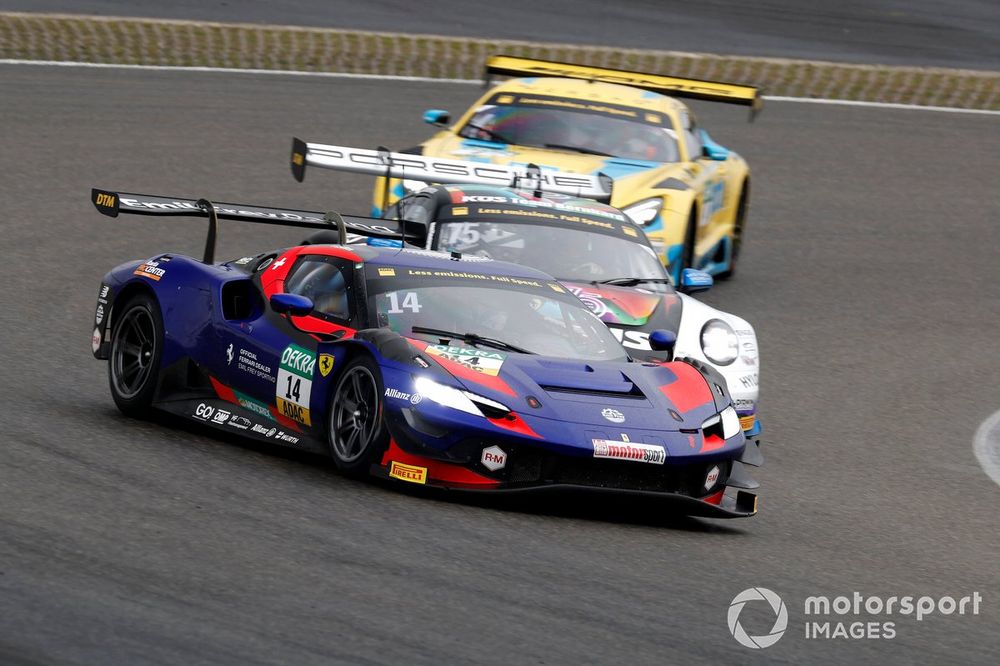
Ferrari was a front-running manufacturer in the first two years of the DTM’s GT3 era in 2021-22, with the factory-supported and Red Bull-branded AF Corse squad even challenging for the title with Liam Lawson in ‘21. However, with AF Corse leaving and being replaced by Emil Frey as Ferrari’s sole representative in the DTM, and the ageing 488 GT3 also making way for the new 296 GT3, results were proving to be much harder to achieve in 2023.
The Emil Frey/Ferrari partnership did get off to a strong note at Oschersleben with Aitken qualifying on the front row on debut and then finishing third in the race, but that had started to seem like a false dawn as errors and inconsistency prevented the team from contending for a podium again.
That was until the fifth round of the season at the Lausitzring, where Aitken, Emil Frey and Ferrari finally lived up to the promise they had shown as they celebrated an impressive an impressive victory from pole position.
Apart from a brief period during the pitstop phase where Lamborghini’s Mirko Bortolotti jumped him with an undercut, Aitken was never headed as he crossed the line 2.4s clear of the field in his blue-and-red Ferrari.
It followed the 296 GT3’s historic victory at the Nurburgring 24 Hours in May, which was a first for a non-German car at the twice-the-round clock enduro since 2002.
So how was Ferrari finally able to take on German heavyweights Audi, BMW, Mercedes and Porsche as well as fellow Italian marque Lamborghini at the Lausitzring? According to Emil Frey Racing boss Lorenz Frey-Hilti, the Balance of Performance changes made in the run up to the race were instrumental in ensuring the 296 GT3 was at a par with its rivals, having previously struggled in a straightline.
The boost pressure of the car, which had fluctuated between 2.36-2.40 bar in the first three rounds, was raised to 2.425 bar at the Nurburgring, before being increased further to 2.525 bar at the Lausitzring.
This meant that the Ferrari went from being the slowest car in speed traps at the start of the season to the second-best in the field, only behind the BMW M4 GT3.

"There has been a big BoP change and we fought hard for that," Frey-Hilti told Motorsport.com’s sister title Motorsport-Total.com. “Lausitzring was the first race, apart from Nurburgring, where we didn't have to fight with blunt weapons in terms of top speed.
"The car is very fast in the corners. We were therefore deprived of so much power that, although we were very good on a free lap in qualifying, we couldn't get off the mark in the race even at the start.
"It was often crazy how we lost three or four places at the start, even though the reaction time of both drivers was very good. The drivers just didn't have any boost.
"If you have no acceleration out of the corners and no top speed, we had races where we were 8-9 km/h slower, then you're fighting with blunt weapons."
Despite feeling that the 296 GT3 was held back by a lack of power in the first half of the season due to BoP, The Emil Frey team sympathises with SRO, which is now responsible for equalising the performance between all six cars in the series.
“I don't want to complain, because it's also very difficult for the people who do the BoP, because you don't have that much data and experience with a new vehicle,” Frey-Hilti said.
“And you never know for sure: Is that really the maximum or did they have a bad set-up? But it was very frustrating that we did a good job in a couple of races and it still wasn't enough."

Ferrari’s new GT3 racer also suffered with brake overheating in the early rounds due to a design flaw, which meant Aitken and his team-mate Thierry Vermeulen had to drive staggered in traffic in order to keep the temperature within limits.
However, this proved to be less of a problem for Aitken last weekend, both due to the track layout and the British driver’s starting position.
"We had certain race tracks where it was brutal," Frey-Hilti explained. "The Norisring is an extreme engine and brake track.
"It certainly helped [at Lausitzring] that Jack was able to drive ahead and never had to drive behind another car for long. But even otherwise it wasn't a big problem for us on this track because there's enough time between the braking zones to cool the system down."
Aitken on his part feels he and Emil Frey were inconsistent in the first half of the season because they were still trying to understand the car, which replaced the 488 GT3 that has been in service since 2016.
Emil Frey was also completely new to Ferrari machinery, having previously campaigned Lamborghini Huracan GT3s in championships such as GT World Challenge Europe and the ADAC GT Masters.
“It's normal when you have a new car and even a new team that there is a learning process. We had the speed, which we saw immediately in Oschersleben,” he explained.
“But we also knew that this was a track where the Ferrari would probably do quite well and these ups and downs that we saw are just trying to learn the car.
“We also had some mistakes on my side and the team as well. It's not been easy to get to a consistent level but I think at the last round in the Nurburgring we showed a good pace but we couldn't get the result, but now we are managing to do a race mistake-free and capitalise.”







